Offshore Supply Vessel Market Size 2025-2029
The offshore supply vessel market size is valued to increase USD 6.62 billion, at a CAGR of 4.6% from 2024 to 2029. Rise in global demand for oil and natural gas will drive the offshore supply vessel market.
Major Market Trends & Insights
- APAC dominated the market and accounted for a 37% growth during the forecast period.
- By Type - AHTS segment was valued at USD 9.51 billion in 2023
- By End-user - Offshore oil and gas segment accounted for the largest market revenue share in 2023
Market Size & Forecast
- Market Opportunities: USD 38.82 billion
- Market Future Opportunities: USD 6.62 billion
- CAGR from 2024 to 2029 : 4.6%
Market Summary
- In the dynamic energy sector, the Offshore Supply Vessel (OSV) market experiences continuous evolution, driven by the escalating global demand for oil and natural gas. This demand fuels the preference for high-capacity OSVs and those utilizing liquefied natural gas (LNG) as fuel. However, this market's growth is not without challenges. Operational costs for OSVs have been on the rise, necessitating innovative solutions and operational efficiencies. The OSV market's size was valued at USD53.7 billion in 2020, reflecting its significant role in the energy industry. As the world's energy needs evolve, so too will the OSV market. Advanced technologies, such as autonomous vessels and digitalization, are poised to revolutionize OSV operations, enhancing safety, efficiency, and sustainability.
- Moreover, the shift towards renewable energy sources may impact the OSV market's future direction. As offshore wind farms expand, the demand for specialized vessels to install, maintain, and service these installations is growing. This diversification could provide new opportunities for OSV operators, ensuring their relevance in an evolving energy landscape. In conclusion, the OSV market's growth is driven by the increasing demand for oil and natural gas, the preference for high-capacity and LNG-fueled vessels, and the need for operational efficiencies. Despite challenges, the market's future direction is influenced by technological advancements, the potential impact of renewable energy, and the continuous evolution of the energy sector.
What will be the Size of the Offshore Supply Vessel Market during the forecast period?
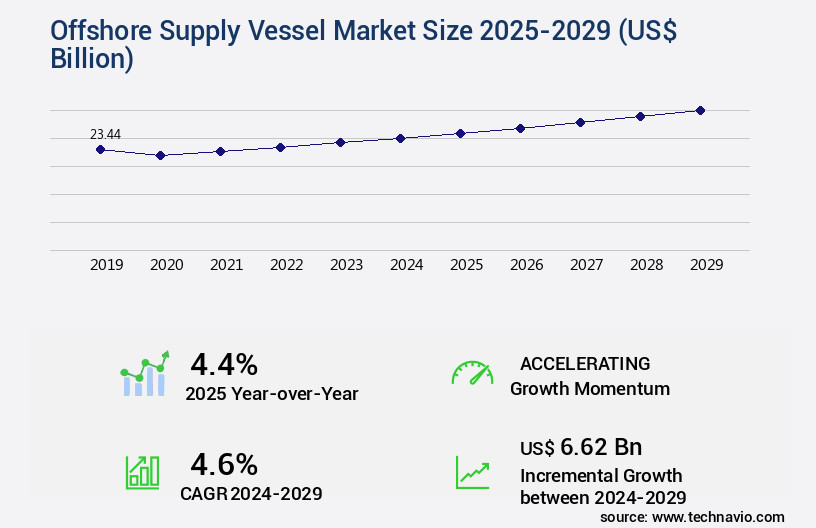
Get Key Insights on Market Forecast (PDF) Request Free Sample
How is the Offshore Supply Vessel Market Segmented ?
The offshore supply vessel industry research report provides comprehensive data (region-wise segment analysis), with forecasts and estimates in "USD billion" for the period 2025-2029, as well as historical data from 2019-2023 for the following segments.
- Type
- End-user
- Offshore oil and gas
- Offshore wind
- Propulsion
- Conventional diesel-powered
- LNG-powered
- Hybrid/electric propulsion
- Geography
- North America
- Europe
- APAC
- South America
- Rest of World (ROW)
By Type Insights
The ahts segment is estimated to witness significant growth during the forecast period.
Offshore supply vessels (OSVs), including platform supply vessels (PSVs, the focus of this discussion), play a pivotal role in the offshore energy sector by transporting essential supplies to oil rigs and carrying cargo from rigs to the shore. PSVs are instrumental in maintaining offshore operations, facilitating construction and maintenance projects in deep waters. These versatile vessels carry a range of equipment and materials, such as diesel fuel, drilling by-products, water, and chemicals, to support underwater drilling activities. PSVs are equipped with advanced systems, including helicopter deck operations, subsea intervention systems, maintenance management systems, deck handling equipment, safety management systems, emergency response procedures, vessel tracking technology, and cargo handling operations.
These systems ensure efficient and safe platform supply operations. Moreover, hull integrity monitoring, vessel motion compensation, and supply boat operations contribute to the overall performance and reliability of the vessel. The dynamic positioning system, propulsion system efficiency, riser handling systems, pollution prevention equipment, crew accommodation standards, ballast water management, diving support operations, environmental monitoring sensors, fire suppression systems, offshore crane capacity, lifeboat deployment systems, supply chain optimization, fuel efficiency metrics, remote operational capabilities, underwater rov operations, anchor handling operations, and automated mooring systems are all integral components of a modern PSV. According to industry reports, over 3,000 OSVs are in operation worldwide, with PSVs accounting for approximately 60% of the total fleet.
This underscores the vital role these vessels play in the offshore energy sector.
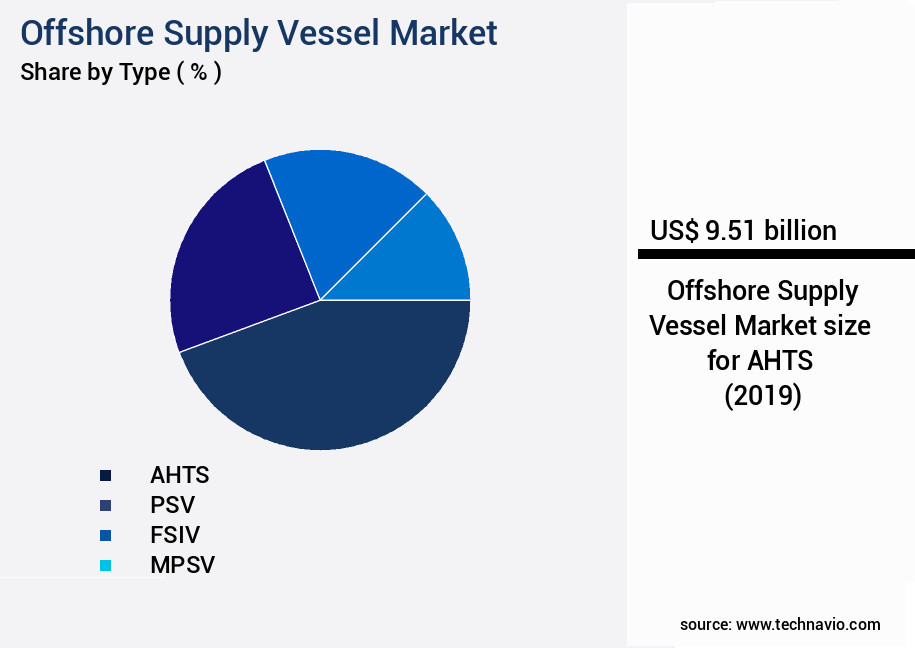
Request Free Sample
The AHTS segment was valued at USD 9.51 billion in 2019 and showed a gradual increase during the forecast period.
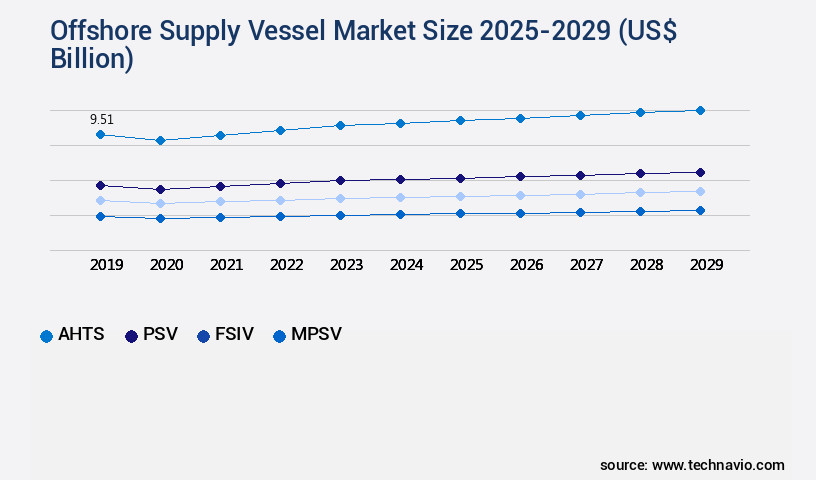
Request Free Sample
Regional Analysis
APAC is estimated to contribute 37% to the growth of the global market during the forecast period.Technavio’s analysts have elaborately explained the regional trends and drivers that shape the market during the forecast period.
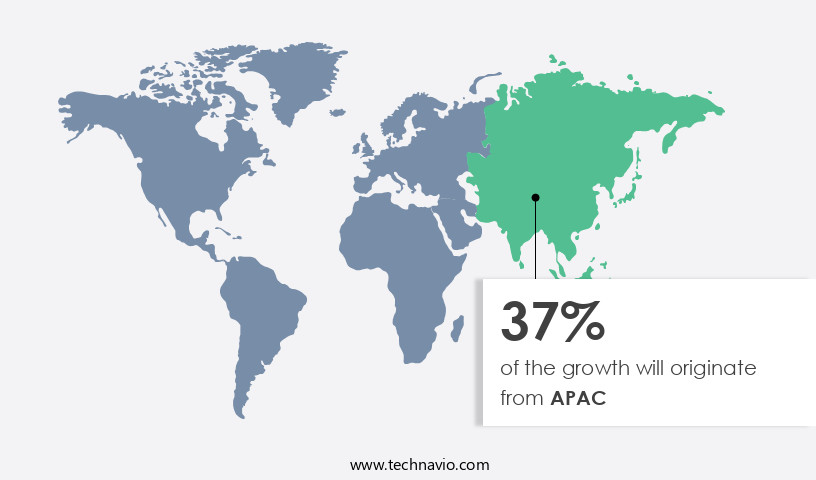
See How Offshore Supply Vessel Market Demand is Rising in APAC Request Free Sample
The market in Asia Pacific (APAC) is experiencing significant growth, driven by the surge in offshore activities in the region. This expansion is primarily attributed to the increasing number of oil rigs and the substantial capital expenditure (CAPEX) in the oil and gas industry. According to industry reports, there is an estimated CAPEX of USD28 billion in APAC from the final investment decision (FID). China is currently the leading country in the offshore vessel market in APAC, with approximately half of the global Anchor Handling, Towing, and Supply (AHTS) vessels and one-fourth of the global Platform Supply Vessels (PSVs) in operation.
The energy demands in developing economies like China and India are increasing due to motorization and infrastructure developments, further fueling the market's robust growth.
Market Dynamics
Our researchers analyzed the data with 2024 as the base year, along with the key drivers, trends, and challenges. A holistic analysis of drivers will help companies refine their marketing strategies to gain a competitive advantage.
The market is a critical component of the offshore energy industry, optimizing operations to transport equipment, personnel, and supplies to offshore installations. Vessel motion compensation technology and dynamic positioning system performance are essential for maintaining stability in harsh marine environments. Offshore crane capacity requirements continue to evolve, necessitating advancements in deck handling equipment maintenance and subsea intervention system capabilities. Fuel efficiency improvements in offshore vessels are a significant focus, as rising operational costs drive the need for more energy-efficient solutions. Innovations in propulsion system efficiency optimization and hull integrity monitoring techniques are key areas of investment. Improving offshore supply vessel safety remains a top priority, with pollution prevention methods for supply vessels and crew accommodation standards compliance essential for environmental sustainability and worker welfare.
Remote operational capabilities for supply vessels, such as vessel tracking technology integration and automated mooring system performance, enable more efficient and cost-effective operations. Navigation and communication system reliability are crucial for ensuring safe and effective vessel performance, while environmental monitoring sensor accuracy and fire suppression system effectiveness are vital for maintaining regulatory compliance. Compared to traditional vessels, modern offshore supply vessels boast significant advancements in technology and design. For instance, more than 70% of new product developments in the offshore vessel sector focus on enhancing vessel performance and safety features. This trend underscores the industry's commitment to addressing the unique challenges of offshore operations and delivering sustainable, efficient, and reliable solutions.
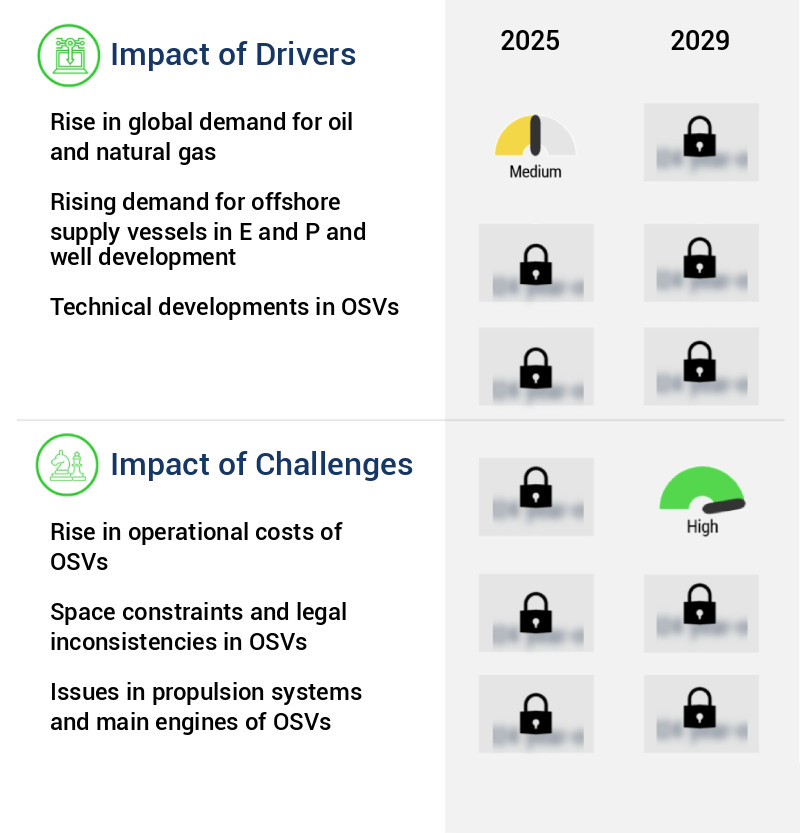
What are the key market drivers leading to the rise in the adoption of Offshore Supply Vessel Industry?
- The escalating global demand for oil and natural gas serves as the primary driver of the market.
- The global demand for oil and natural gas continues to escalate due to expanding economic growth, with the Energy Information Administration (EIA) projecting global oil consumption to reach 104.1 million barrels per day (mb/d) by 2026. This represents a significant increase of 4.4 mb/d from 2019 levels. Consequently, the exploration and production (E&P) industry must discover and drill new oil and gas reservoirs as existing ones mature or deplete. The shift towards offshore E&P activities is a response to the larger size and longer product life of offshore reservoirs compared to onshore ones.
- This trend is evident as companies prioritize offshore drilling to meet the growing demand for oil and gas. It is essential for businesses to stay informed of these evolving market dynamics and adapt accordingly.
What are the market trends shaping the Offshore Supply Vessel Industry?
- The increasing demand for high-capacity and liquefied natural gas (LNG)-fueled Offshore Support Vessels (OSVs) represents a significant market trend in the maritime industry.
- The high-capacity vessel market is experiencing a surge in demand due to the increasing need for transporting large quantities of goods, particularly in the context of expanding remote deepwater activities worldwide. These vessels boast high engine capacity, efficient propellers, substantial bollard pull, expansive decks, ample below-deck space, and helipad areas, as well as robust winches. The cargo load capacity of these vessels is notably high, making them indispensable for bulk transportation. The anticipated recovery of oil prices is expected to fuel the demand for high-capacity vessels, as offshore oil and gas exploration and production activities gain momentum.
- Moreover, the market is witnessing a shift towards LNG-fueled OSVs (Offshore Support Vessels), as they offer cost savings and eco-friendly advantages over diesel-fueled OSVs. This trend is poised to significantly impact the high-capacity vessel market, as LNG becomes an increasingly popular fuel source for offshore operations.
What challenges does the Offshore Supply Vessel Industry face during its growth?
- The escalating operational costs of Offshore Support Vessels (OSVs) pose a significant challenge to the growth of the industry. This issue, which is mandatory for industry professionals to address, arises from various factors such as increasing fuel prices, maintenance costs, and crew wages. Effective cost management and the implementation of innovative solutions, like the adoption of energy-efficient technologies and optimization of operational processes, are crucial to mitigating this challenge and ensuring the sustainable growth of the OSV sector.
- The offshore supply vessel (OSV) market encounters significant challenges due to substantial capital investments and infrastructure necessities for constructing and maintaining the OSV fleet. The maintenance of these vessels entails high costs, including engine and tug upkeep, crew expenditures, and regular maintenance, repair, and operations (MRO) expenses. Furthermore, a considerable portion of investments in the global OSV market originates from external financing, potentially leading to substantial debts. Operational risks are prevalent in the OSV sector, encompassing technical and mechanical failures, exposure to harsh weather conditions, pirate attacks, and collisions with other vessels.
- Despite these challenges, the market continues to evolve, with ongoing activities and emerging trends shaping its applications across various industries, such as oil and gas exploration and renewable energy.
Exclusive Technavio Analysis on Customer Landscape
The offshore supply vessel market forecasting report includes the adoption lifecycle of the market, covering from the innovator’s stage to the laggard’s stage. It focuses on adoption rates in different regions based on penetration. Furthermore, the offshore supply vessel market report also includes key purchase criteria and drivers of price sensitivity to help companies evaluate and develop their market growth analysis strategies.
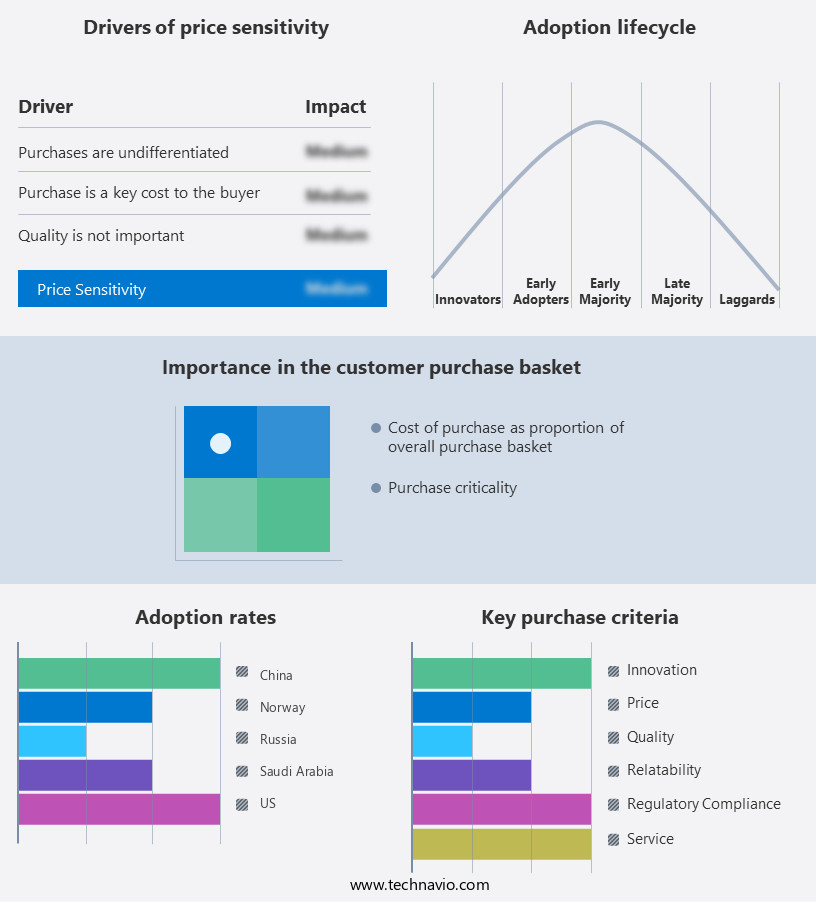
Customer Landscape of Offshore Supply Vessel Industry
Competitive Landscape
Companies are implementing various strategies, such as strategic alliances, offshore supply vessel market forecast, partnerships, mergers and acquisitions, geographical expansion, and product/service launches, to enhance their presence in the industry.
AP Moller Maersk AS - This company specializes in providing offshore supply vessels, including M class anchor handling tug supply vessels, to the global energy industry. These vessels ensure efficient and safe operations in challenging offshore environments. With a focus on innovation and reliability, the company's offerings enhance the productivity of offshore projects.
The industry research and growth report includes detailed analyses of the competitive landscape of the market and information about key companies, including:
- AP Moller Maersk AS
- Bass Marine Pty Ltd.
- BOURBON Maritime
- Damen Shipyards Group
- DP World
- Edison Chouest Offshore Co.
- Harren Shipping Services GmbH and Co. KG
- Harvey Gulf International Marine LLC
- Havila Shipping ASA
- Hornbeck Offshore Services Inc.
- Island Offshore Management AS
- Nam Cheong Ltd.
- Qatar Navigation QPSC
- SEACOR Marine Holdings Inc.
- Siem Offshore Inc.
- Solstad Offshore ASA
- Tidewater Inc.
- Van Aalst Group
- Vroon BV
- Wartsila Corp.
Qualitative and quantitative analysis of companies has been conducted to help clients understand the wider business environment as well as the strengths and weaknesses of key industry players. Data is qualitatively analyzed to categorize companies as pure play, category-focused, industry-focused, and diversified; it is quantitatively analyzed to categorize companies as dominant, leading, strong, tentative, and weak.
Recent Development and News in Offshore Supply Vessel Market
- In January 2024, Norwegian offshore vessel owner and operator, Solstad Offshore, announced a strategic partnership with Siem Offshore AS to jointly offer renewable energy solutions, integrating Solstad's fleet of offshore supply vessels with Siem's renewable energy expertise (Solstad Offshore Press Release).
- In March 2024, Singaporean offshore vessel provider, Sembcorp Marine, secured a major contract worth approximately USD1.2 billion to construct and deliver a newbuild multi-purpose offshore support vessel for a leading international oil and gas company (Sembcorp Marine Press Release).
- In May 2024, the Norwegian Maritime Authority granted a significant regulatory approval to Norwegian offshore vessel owner and operator, Eastern Shipbuilding Group, allowing it to expand its operations in the Norwegian Continental Shelf (NCS) (Norwegian Maritime Authority Press Release).
- In April 2025, Danish offshore vessel provider, Maersk Supply Service, showcased a new generation of offshore wind service vessels, featuring advanced technology for efficient and safe wind farm operations (Maersk Supply Service Press Release).
Dive into Technavio’s robust research methodology, blending expert interviews, extensive data synthesis, and validated models for unparalleled Offshore Supply Vessel Market insights. See full methodology.
|
Market Scope
|
|
Report Coverage
|
Details
|
|
Page number
|
219
|
|
Base year
|
2024
|
|
Historic period
|
2019-2023 |
|
Forecast period
|
2025-2029
|
|
Growth momentum & CAGR
|
Accelerate at a CAGR of 4.6%
|
|
Market growth 2025-2029
|
USD 6.62 billion
|
|
Market structure
|
Fragmented
|
|
YoY growth 2024-2025(%)
|
4.4
|
|
Key countries
|
China, US, Russia, Saudi Arabia, Japan, Norway, Canada, Brazil, and India
|
|
Competitive landscape
|
Leading Companies, Market Positioning of Companies, Competitive Strategies, and Industry Risks
|
Request Free Sample
Research Analyst Overview
- Amidst the dynamic offshore energy landscape, the role of offshore supply vessels (OSVs) remains pivotal, continually evolving to meet the demands of helicopter deck operations, subsea intervention systems, and platform supply operations. These versatile maritime assets are integral to the success of offshore projects, enabling efficient deployment of personnel and equipment. One striking trend in the OSV market is the increasing integration of advanced technologies. For instance, vessel tracking technology and automated mooring systems streamline operations, while safety management systems and emergency response procedures enhance safety and mitigate risks. Moreover, the adoption of dynamic positioning systems and underwater ROV operations bolsters subsea intervention capabilities.
- Another key driver is the growing emphasis on efficiency and sustainability. Fuel efficiency metrics and propulsion system efficiency are under the spotlight, with hull integrity monitoring and ballast water management systems playing crucial roles in reducing environmental impact. Furthermore, remote operational capabilities and supply chain optimization are transforming the way OSVs support offshore projects. A recent study reveals that over 60% of the total offshore support vessel market value is attributed to platform supply vessels. This underscores their indispensable role in transporting cargo, fuel, water, and personnel to offshore installations. However, challenges persist, including the need for crew accommodation standards that meet stringent regulations and the integration of fire suppression systems and pollution prevention equipment.
- In conclusion, the market is a dynamic and evolving sector, shaped by the integration of advanced technologies, the pursuit of efficiency and sustainability, and the demands of various offshore operations. This diverse landscape presents both opportunities and challenges for stakeholders, making it an intriguing area for further exploration.
What are the Key Data Covered in this Offshore Supply Vessel Market Research and Growth Report?
-
What is the expected growth of the Offshore Supply Vessel Market between 2025 and 2029?
-
What segmentation does the market report cover?
-
The report is segmented by Type (AHTS, PSV, FSIV, MPSV, and Others), End-user (Offshore oil and gas and Offshore wind), Propulsion (Conventional diesel-powered, LNG-powered, and Hybrid/electric propulsion), and Geography (APAC, Europe, North America, Middle East and Africa, and South America)
-
Which regions are analyzed in the report?
-
APAC, Europe, North America, Middle East and Africa, and South America
-
What are the key growth drivers and market challenges?
-
Who are the major players in the Offshore Supply Vessel Market?
-
AP Moller Maersk AS, Bass Marine Pty Ltd., BOURBON Maritime, Damen Shipyards Group, DP World, Edison Chouest Offshore Co., Harren Shipping Services GmbH and Co. KG, Harvey Gulf International Marine LLC, Havila Shipping ASA, Hornbeck Offshore Services Inc., Island Offshore Management AS, Nam Cheong Ltd., Qatar Navigation QPSC, SEACOR Marine Holdings Inc., Siem Offshore Inc., Solstad Offshore ASA, Tidewater Inc., Van Aalst Group, Vroon BV, and Wartsila Corp.
Market Research Insights
- The market encompasses a diverse range of specialized vessels designed to support various offshore energy and marine construction projects. These vessels employ advanced cargo securement methods, satellite communication systems, and risk assessment matrices to ensure safe and efficient operations. Two key performance indicators highlight the market's evolving nature: supply vessel deadweight and deck space utilization. For instance, a modern offshore supply vessel may boast a deadweight capacity of 10,000 metric tons, enabling it to transport larger quantities of cargo. Meanwhile, optimized deck space utilization can accommodate more equipment and personnel, increasing operational efficiency. In turn, this enhances project timelines and reduces overall costs.
- Moreover, stringent IMO safety regulations mandate the integration of fire detection systems, life-saving appliances, and oil spill response equipment. Additionally, ballast water treatment, engine performance data analysis, and survey equipment integration ensure regulatory compliance and environmental sustainability. Further advancements include the integration of autonomous vessel systems, logistics management, and subsea cable installation technology, underscoring the market's continuous evolution.
We can help! Our analysts can customize this offshore supply vessel market research report to meet your requirements.
Get in touch
1 Executive Summary
- 1.1 Market overview
- Executive Summary - Chart on Market Overview
- Executive Summary - Data Table on Market Overview
- Executive Summary - Chart on Global Market Characteristics
- Executive Summary - Chart on Market by Geography
- Executive Summary - Chart on Market Segmentation by Type
- Executive Summary - Chart on Market Segmentation by End-user
- Executive Summary - Chart on Market Segmentation by Propulsion
- Executive Summary - Chart on Incremental Growth
- Executive Summary - Data Table on Incremental Growth
- Executive Summary - Chart on Company Market Positioning
2 Technavio Analysis
- 2.1 Analysis of price sensitivity, lifecycle, customer purchase basket, adoption rates, and purchase criteria
- Analysis of price sensitivity, lifecycle, customer purchase basket, adoption rates, and purchase criteria
- 2.2 Criticality of inputs and Factors of differentiation
- Overview on criticality of inputs and factors of differentiation
- 2.3 Factors of disruption
- Overview on factors of disruption
- 2.4 Impact of drivers and challenges
- Impact of drivers and challenges in 2024 and 2029
3 Market Landscape
- 3.1 Market ecosystem
- Parent Market
- Data Table on - Parent Market
- 3.2 Market characteristics
- Market characteristics analysis
4 Market Sizing
- 4.1 Market definition
- Offerings of companies included in the market definition
- 4.2 Market segment analysis
- 4.4 Market outlook: Forecast for 2024-2029
- Chart on Global - Market size and forecast 2024-2029 ($ billion)
- Data Table on Global - Market size and forecast 2024-2029 ($ billion)
- Chart on Global Market: Year-over-year growth 2024-2029 (%)
- Data Table on Global Market: Year-over-year growth 2024-2029 (%)
5 Historic Market Size
- 5.1 Global Offshore Supply Vessel Market 2019 - 2023
- Historic Market Size - Data Table on Global Offshore Supply Vessel Market 2019 - 2023 ($ billion)
- 5.2 Type segment analysis 2019 - 2023
- Historic Market Size - Type Segment 2019 - 2023 ($ billion)
- 5.3 End-user segment analysis 2019 - 2023
- Historic Market Size - End-user Segment 2019 - 2023 ($ billion)
- 5.4 Propulsion segment analysis 2019 - 2023
- Historic Market Size - Propulsion Segment 2019 - 2023 ($ billion)
- 5.5 Geography segment analysis 2019 - 2023
- Historic Market Size - Geography Segment 2019 - 2023 ($ billion)
- 5.6 Country segment analysis 2019 - 2023
- Historic Market Size - Country Segment 2019 - 2023 ($ billion)
6 Qualitative Analysis
- 6.1 The AI impact on Global Offshore Supply Vessel Market
7 Five Forces Analysis
- 7.1 Five forces summary
- Five forces analysis - Comparison between 2024 and 2029
- 7.2 Bargaining power of buyers
- Bargaining power of buyers - Impact of key factors 2024 and 2029
- 7.3 Bargaining power of suppliers
- Bargaining power of suppliers - Impact of key factors in 2024 and 2029
- 7.4 Threat of new entrants
- Threat of new entrants - Impact of key factors in 2024 and 2029
- 7.5 Threat of substitutes
- Threat of substitutes - Impact of key factors in 2024 and 2029
- 7.6 Threat of rivalry
- Threat of rivalry - Impact of key factors in 2024 and 2029
- 7.7 Market condition
- Chart on Market condition - Five forces 2024 and 2029
8 Market Segmentation by Type
- 8.1 Market segments
- Chart on Type - Market share 2024-2029 (%)
- Data Table on Type - Market share 2024-2029 (%)
- 8.2 Comparison by Type
- Chart on Comparison by Type
- Data Table on Comparison by Type
- 8.3 AHTS - Market size and forecast 2024-2029
- Chart on AHTS - Market size and forecast 2024-2029 ($ billion)
- Data Table on AHTS - Market size and forecast 2024-2029 ($ billion)
- Chart on AHTS - Year-over-year growth 2024-2029 (%)
- Data Table on AHTS - Year-over-year growth 2024-2029 (%)
- 8.4 PSV - Market size and forecast 2024-2029
- Chart on PSV - Market size and forecast 2024-2029 ($ billion)
- Data Table on PSV - Market size and forecast 2024-2029 ($ billion)
- Chart on PSV - Year-over-year growth 2024-2029 (%)
- Data Table on PSV - Year-over-year growth 2024-2029 (%)
- 8.5 FSIV - Market size and forecast 2024-2029
- Chart on FSIV - Market size and forecast 2024-2029 ($ billion)
- Data Table on FSIV - Market size and forecast 2024-2029 ($ billion)
- Chart on FSIV - Year-over-year growth 2024-2029 (%)
- Data Table on FSIV - Year-over-year growth 2024-2029 (%)
- 8.6 MPSV - Market size and forecast 2024-2029
- Chart on MPSV - Market size and forecast 2024-2029 ($ billion)
- Data Table on MPSV - Market size and forecast 2024-2029 ($ billion)
- Chart on MPSV - Year-over-year growth 2024-2029 (%)
- Data Table on MPSV - Year-over-year growth 2024-2029 (%)
- 8.7 Others - Market size and forecast 2024-2029
- Chart on Others - Market size and forecast 2024-2029 ($ billion)
- Data Table on Others - Market size and forecast 2024-2029 ($ billion)
- Chart on Others - Year-over-year growth 2024-2029 (%)
- Data Table on Others - Year-over-year growth 2024-2029 (%)
- 8.8 Market opportunity by Type
- Market opportunity by Type ($ billion)
- Data Table on Market opportunity by Type ($ billion)
9 Market Segmentation by End-user
- 9.1 Market segments
- Chart on End-user - Market share 2024-2029 (%)
- Data Table on End-user - Market share 2024-2029 (%)
- 9.2 Comparison by End-user
- Chart on Comparison by End-user
- Data Table on Comparison by End-user
- 9.3 Offshore oil and gas - Market size and forecast 2024-2029
- Chart on Offshore oil and gas - Market size and forecast 2024-2029 ($ billion)
- Data Table on Offshore oil and gas - Market size and forecast 2024-2029 ($ billion)
- Chart on Offshore oil and gas - Year-over-year growth 2024-2029 (%)
- Data Table on Offshore oil and gas - Year-over-year growth 2024-2029 (%)
- 9.4 Offshore wind - Market size and forecast 2024-2029
- Chart on Offshore wind - Market size and forecast 2024-2029 ($ billion)
- Data Table on Offshore wind - Market size and forecast 2024-2029 ($ billion)
- Chart on Offshore wind - Year-over-year growth 2024-2029 (%)
- Data Table on Offshore wind - Year-over-year growth 2024-2029 (%)
- 9.5 Market opportunity by End-user
- Market opportunity by End-user ($ billion)
- Data Table on Market opportunity by End-user ($ billion)
10 Market Segmentation by Propulsion
- 10.1 Market segments
- Chart on Propulsion - Market share 2024-2029 (%)
- Data Table on Propulsion - Market share 2024-2029 (%)
- 10.2 Comparison by Propulsion
- Chart on Comparison by Propulsion
- Data Table on Comparison by Propulsion
- 10.3 Conventional diesel-powered - Market size and forecast 2024-2029
- Chart on Conventional diesel-powered - Market size and forecast 2024-2029 ($ billion)
- Data Table on Conventional diesel-powered - Market size and forecast 2024-2029 ($ billion)
- Chart on Conventional diesel-powered - Year-over-year growth 2024-2029 (%)
- Data Table on Conventional diesel-powered - Year-over-year growth 2024-2029 (%)
- 10.4 LNG-powered - Market size and forecast 2024-2029
- Chart on LNG-powered - Market size and forecast 2024-2029 ($ billion)
- Data Table on LNG-powered - Market size and forecast 2024-2029 ($ billion)
- Chart on LNG-powered - Year-over-year growth 2024-2029 (%)
- Data Table on LNG-powered - Year-over-year growth 2024-2029 (%)
- 10.5 Hybrid/electric propulsion - Market size and forecast 2024-2029
- Chart on Hybrid/electric propulsion - Market size and forecast 2024-2029 ($ billion)
- Data Table on Hybrid/electric propulsion - Market size and forecast 2024-2029 ($ billion)
- Chart on Hybrid/electric propulsion - Year-over-year growth 2024-2029 (%)
- Data Table on Hybrid/electric propulsion - Year-over-year growth 2024-2029 (%)
- 10.6 Market opportunity by Propulsion
- Market opportunity by Propulsion ($ billion)
- Data Table on Market opportunity by Propulsion ($ billion)
11 Customer Landscape
- 11.1 Customer landscape overview
- Analysis of price sensitivity, lifecycle, customer purchase basket, adoption rates, and purchase criteria
12 Geographic Landscape
- 12.1 Geographic segmentation
- Chart on Market share by geography 2024-2029 (%)
- Data Table on Market share by geography 2024-2029 (%)
- 12.2 Geographic comparison
- Chart on Geographic comparison
- Data Table on Geographic comparison
- 12.3 APAC - Market size and forecast 2024-2029
- Chart on APAC - Market size and forecast 2024-2029 ($ billion)
- Data Table on APAC - Market size and forecast 2024-2029 ($ billion)
- Chart on APAC - Year-over-year growth 2024-2029 (%)
- Data Table on APAC - Year-over-year growth 2024-2029 (%)
- 12.4 Europe - Market size and forecast 2024-2029
- Chart on Europe - Market size and forecast 2024-2029 ($ billion)
- Data Table on Europe - Market size and forecast 2024-2029 ($ billion)
- Chart on Europe - Year-over-year growth 2024-2029 (%)
- Data Table on Europe - Year-over-year growth 2024-2029 (%)
- 12.5 North America - Market size and forecast 2024-2029
- Chart on North America - Market size and forecast 2024-2029 ($ billion)
- Data Table on North America - Market size and forecast 2024-2029 ($ billion)
- Chart on North America - Year-over-year growth 2024-2029 (%)
- Data Table on North America - Year-over-year growth 2024-2029 (%)
- 12.6 Middle East and Africa - Market size and forecast 2024-2029
- Chart on Middle East and Africa - Market size and forecast 2024-2029 ($ billion)
- Data Table on Middle East and Africa - Market size and forecast 2024-2029 ($ billion)
- Chart on Middle East and Africa - Year-over-year growth 2024-2029 (%)
- Data Table on Middle East and Africa - Year-over-year growth 2024-2029 (%)
- 12.7 South America - Market size and forecast 2024-2029
- Chart on South America - Market size and forecast 2024-2029 ($ billion)
- Data Table on South America - Market size and forecast 2024-2029 ($ billion)
- Chart on South America - Year-over-year growth 2024-2029 (%)
- Data Table on South America - Year-over-year growth 2024-2029 (%)
- 12.8 China - Market size and forecast 2024-2029
- Chart on China - Market size and forecast 2024-2029 ($ billion)
- Data Table on China - Market size and forecast 2024-2029 ($ billion)
- Chart on China - Year-over-year growth 2024-2029 (%)
- Data Table on China - Year-over-year growth 2024-2029 (%)
- 12.9 US - Market size and forecast 2024-2029
- Chart on US - Market size and forecast 2024-2029 ($ billion)
- Data Table on US - Market size and forecast 2024-2029 ($ billion)
- Chart on US - Year-over-year growth 2024-2029 (%)
- Data Table on US - Year-over-year growth 2024-2029 (%)
- 12.10 Russia - Market size and forecast 2024-2029
- Chart on Russia - Market size and forecast 2024-2029 ($ billion)
- Data Table on Russia - Market size and forecast 2024-2029 ($ billion)
- Chart on Russia - Year-over-year growth 2024-2029 (%)
- Data Table on Russia - Year-over-year growth 2024-2029 (%)
- 12.11 Saudi Arabia - Market size and forecast 2024-2029
- Chart on Saudi Arabia - Market size and forecast 2024-2029 ($ billion)
- Data Table on Saudi Arabia - Market size and forecast 2024-2029 ($ billion)
- Chart on Saudi Arabia - Year-over-year growth 2024-2029 (%)
- Data Table on Saudi Arabia - Year-over-year growth 2024-2029 (%)
- 12.12 Japan - Market size and forecast 2024-2029
- Chart on Japan - Market size and forecast 2024-2029 ($ billion)
- Data Table on Japan - Market size and forecast 2024-2029 ($ billion)
- Chart on Japan - Year-over-year growth 2024-2029 (%)
- Data Table on Japan - Year-over-year growth 2024-2029 (%)
- 12.13 Norway - Market size and forecast 2024-2029
- Chart on Norway - Market size and forecast 2024-2029 ($ billion)
- Data Table on Norway - Market size and forecast 2024-2029 ($ billion)
- Chart on Norway - Year-over-year growth 2024-2029 (%)
- Data Table on Norway - Year-over-year growth 2024-2029 (%)
- 12.14 Canada - Market size and forecast 2024-2029
- Chart on Canada - Market size and forecast 2024-2029 ($ billion)
- Data Table on Canada - Market size and forecast 2024-2029 ($ billion)
- Chart on Canada - Year-over-year growth 2024-2029 (%)
- Data Table on Canada - Year-over-year growth 2024-2029 (%)
- 12.15 Brazil - Market size and forecast 2024-2029
- Chart on Brazil - Market size and forecast 2024-2029 ($ billion)
- Data Table on Brazil - Market size and forecast 2024-2029 ($ billion)
- Chart on Brazil - Year-over-year growth 2024-2029 (%)
- Data Table on Brazil - Year-over-year growth 2024-2029 (%)
- 12.16 India - Market size and forecast 2024-2029
- Chart on India - Market size and forecast 2024-2029 ($ billion)
- Data Table on India - Market size and forecast 2024-2029 ($ billion)
- Chart on India - Year-over-year growth 2024-2029 (%)
- Data Table on India - Year-over-year growth 2024-2029 (%)
- 12.17 Market opportunity by geography
- Market opportunity by geography ($ billion)
- Data Tables on Market opportunity by geography ($ billion)
13 Drivers, Challenges, and Opportunity/Restraints
- 13.3 Impact of drivers and challenges
- Impact of drivers and challenges in 2024 and 2029
- 13.4 Market opportunities/restraints
14 Competitive Landscape
- 14.2 Competitive Landscape
- Overview on criticality of inputs and factors of differentiation
- 14.3 Landscape disruption
- Overview on factors of disruption
- 14.4 Industry risks
- Impact of key risks on business
15 Competitive Analysis
- 15.2 Company ranking index
- 15.3 Market positioning of companies
- Matrix on companies position and classification
- 15.4 AP Moller Maersk AS
- AP Moller Maersk AS - Overview
- AP Moller Maersk AS - Business segments
- AP Moller Maersk AS - Key news
- AP Moller Maersk AS - Key offerings
- AP Moller Maersk AS - Segment focus
- SWOT
- 15.5 Bass Marine Pty Ltd.
- Bass Marine Pty Ltd. - Overview
- Bass Marine Pty Ltd. - Product / Service
- Bass Marine Pty Ltd. - Key offerings
- SWOT
- 15.6 BOURBON Maritime
- BOURBON Maritime - Overview
- BOURBON Maritime - Product / Service
- BOURBON Maritime - Key offerings
- SWOT
- 15.7 DP World
- DP World - Overview
- DP World - Product / Service
- DP World - Key offerings
- SWOT
- 15.8 Edison Chouest Offshore Co.
- Edison Chouest Offshore Co. - Overview
- Edison Chouest Offshore Co. - Product / Service
- Edison Chouest Offshore Co. - Key offerings
- SWOT
- 15.9 Harren Shipping Services GmbH and Co. KG
- Harren Shipping Services GmbH and Co. KG - Overview
- Harren Shipping Services GmbH and Co. KG - Product / Service
- Harren Shipping Services GmbH and Co. KG - Key offerings
- SWOT
- 15.10 Harvey Gulf International Marine LLC
- Harvey Gulf International Marine LLC - Overview
- Harvey Gulf International Marine LLC - Product / Service
- Harvey Gulf International Marine LLC - Key offerings
- SWOT
- 15.11 Havila Shipping ASA
- Havila Shipping ASA - Overview
- Havila Shipping ASA - Product / Service
- Havila Shipping ASA - Key offerings
- SWOT
- 15.12 Hornbeck Offshore Services Inc.
- Hornbeck Offshore Services Inc. - Overview
- Hornbeck Offshore Services Inc. - Product / Service
- Hornbeck Offshore Services Inc. - Key offerings
- SWOT
- 15.13 Island Offshore Management AS
- Island Offshore Management AS - Overview
- Island Offshore Management AS - Product / Service
- Island Offshore Management AS - Key offerings
- SWOT
- 15.14 Qatar Navigation QPSC
- Qatar Navigation QPSC - Overview
- Qatar Navigation QPSC - Product / Service
- Qatar Navigation QPSC - Key offerings
- SWOT
- 15.15 SEACOR Marine Holdings Inc.
- SEACOR Marine Holdings Inc. - Overview
- SEACOR Marine Holdings Inc. - Business segments
- SEACOR Marine Holdings Inc. - Key offerings
- SEACOR Marine Holdings Inc. - Segment focus
- SWOT
- 15.16 Siem Offshore Inc.
- Siem Offshore Inc. - Overview
- Siem Offshore Inc. - Product / Service
- Siem Offshore Inc. - Key offerings
- SWOT
- 15.17 Solstad Offshore ASA
- Solstad Offshore ASA - Overview
- Solstad Offshore ASA - Product / Service
- Solstad Offshore ASA - Key offerings
- SWOT
- 15.18 Tidewater Inc.
- Tidewater Inc. - Overview
- Tidewater Inc. - Business segments
- Tidewater Inc. - Key offerings
- Tidewater Inc. - Segment focus
- SWOT
16 Appendix
- 16.2 Inclusions and exclusions checklist
- Inclusions checklist
- Exclusions checklist
- 16.3 Currency conversion rates for US$
- Currency conversion rates for US$
- 16.4 Research methodology
- 16.7 Validation techniques employed for market sizing
- Validation techniques employed for market sizing
- 16.9 360 degree market analysis
- 360 degree market analysis
- 16.10 List of abbreviations







![]() Get the report (PDF) sent to your email within minutes.
Get the report (PDF) sent to your email within minutes.
Complimentary full Excel data with your report purchase.